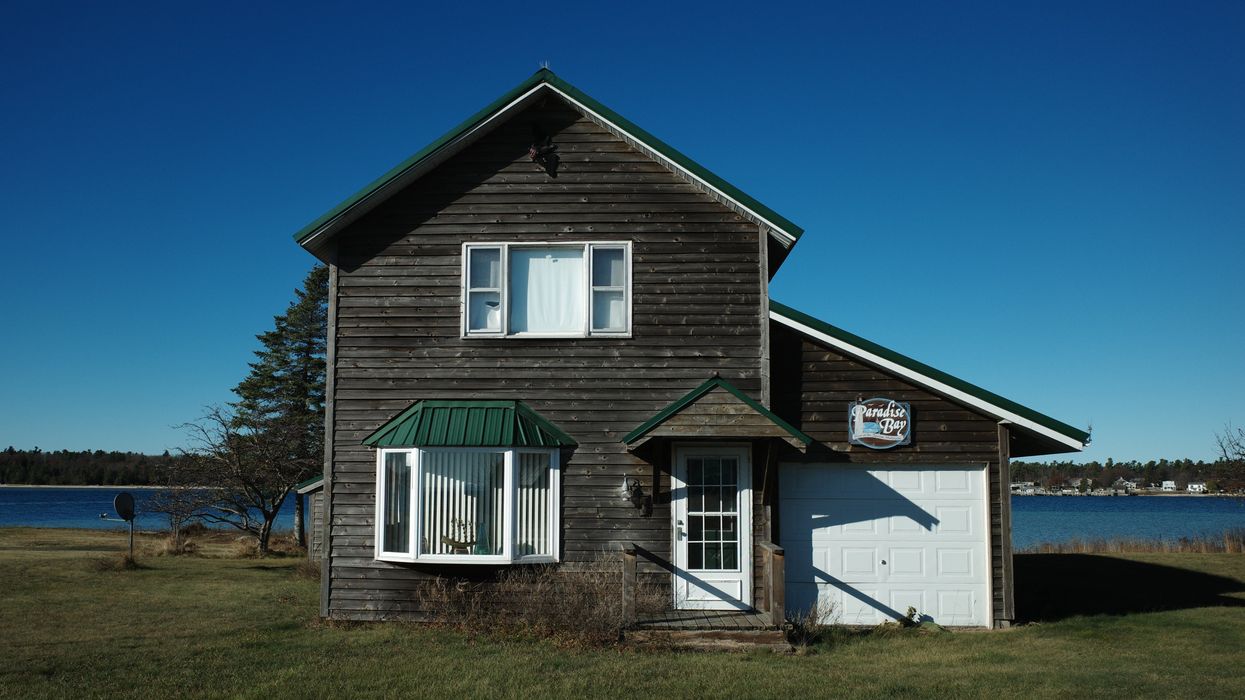
O. W. Root

Somewhere past the edge of comfort and civilization, an island waits for those with no need to be anywhere else.
St. James, Beaver Island is honest. Every nook and cranny of life here is real, unadulterated. It shares nothing in common with the slick, polished, Disney-like facade of Mackinac or Nantucket. It’s not a resort getaway for the ultra wealthy. It’s not a luxurious escape with the finest hotels pampering the softest hands. It’s not a false front on a Hollywood set.
It’s too small and too far away for the faint of heart. This distance filters out the weak, who dream of an island in name only. You can’t see St. James from the mainland. It’s somewhere else—far away. To live on Beaver Island is to turn yourself over to the brutal reality of life past the edge. When the wind scrapes over Lake Michigan’s cold ice sheet in the middle of February, the isolation of life on this island is unbearable for most. When the water turns rough in late autumn, the island begins to feel farther away. The distance feels greater; the island, more isolated. Beaver Island selects for the toughest individuals. Only those who have a thicker skin choose a life here.
On this island in the northern stretch of Lake Michigan, there is an inescapable loneliness or disconnectedness that falls over us. But it’s not discomforting — it’s like an opening of the self. A feeling of liberation and knowledge of place.
The sky was a flat sheet of gray on the mainland the day we headed over. The water, cobalt blue. Empty cottages with dark windows clung to the the shore. Spit from the cold lake floated in the air. We waited silently on the dock at Charlevoix, a little town tucked away in the northwest corner of Michigan.
The wind up here stings all year-round, but there’s none like the one that comes up in November. It feels like the air is going to burst into rain, snow, or some mix of both. But it doesn’t. It just hangs there, needling at your lips and cheeks, daring you to break. We stood in little packs—motionless—watching the ferry, waiting for the call to come aboard.
No one just passes through the northwest corner of Michigan. The little dock in Charlevoix (pop. 3,000) is far from any great hub of civilization. No freeway leads into town. The county has a population of about 19 people per square mile. It’s the very edge of the lower peninsula—as far from Detroit as you can get—but it’s not where we are going. It’s not the edge of civilization.
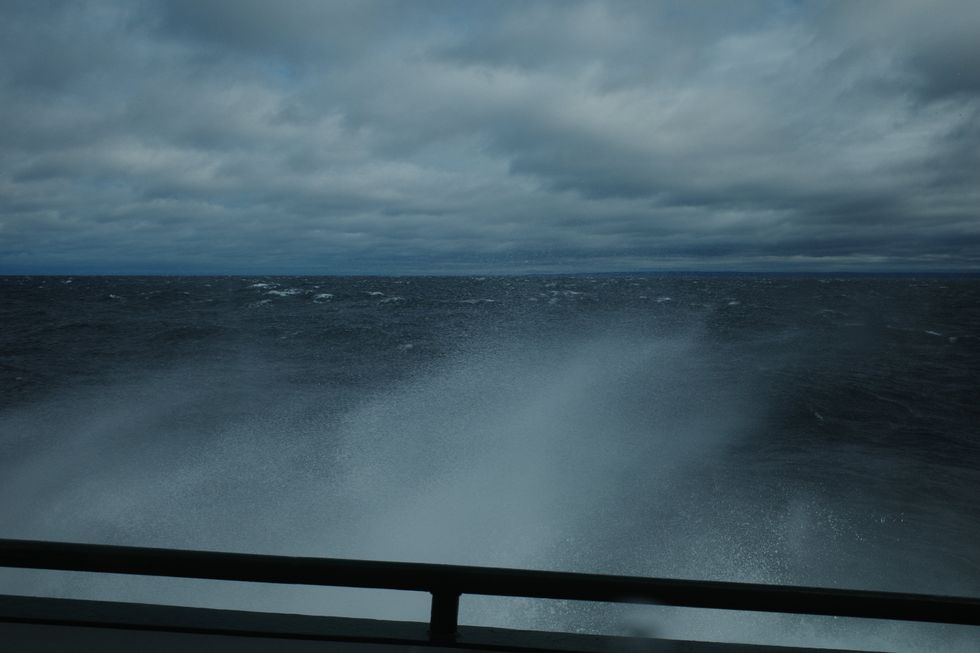
The ferry started its slow lurch down the channel and out into the open water of Lake Michigan around 10:30 a.m. on a Tuesday in early November. We passed the red lighthouse on the southern pier, and the waves started coming in hard. Wind whipped off the water from the north at 30 miles per hour. I watched the wooden cottages on the shore, tucked behind pines, fade into the distance as the ship carried us out into the waves.
For 90 minutes, the little ferry battled its way through the rough water. The engine bellowed under our seats. Mechanical growls interrupted eerie breaks of silence as the bow came up, only to smack down like a hammer on an anvil a few seconds later. Waves crashed over the white railings—water pelting the windows. At points, we were so lopsided, the terrifying, steel water subsumed the sky through the windows on the starboard side.
Only a few of us were on the ferry. Most of us sat glued to our seats the entire time. It was impossible to walk without holding on for dear life. The restroom was off limits. While sitting, I found myself grabbing onto either side of the chair with all the strength I could muster just to stabilize and stay in one place. White knuckled. Passengers were hunched over in their seats, throwing up into paper bags. Eyes closed. Breathing hard. An old man of about 70 sporting a Mackinaw jacket and white beard stood up the entire time—both palms grasping the seat in front of him, staring out over the bow, his eyes fixed on the horizon.
After an hour and a half, the skies cleared, the winds died down, the water grew calm, and we saw Beaver Island on the horizon. Thick woods ran onto the shore—only a thin line of golden sand separating the water below. A single house peaked out through a clearing on the southern side. Two hours after leaving the mainland, our boat came into Paradise Bay at St. James, Beaver Island.
Six hundred people live year-round on this desolate island in the middle of Lake Michigan. Ferries run frequently in the summer, but as autumn rolls on, the schedule thins out. By October, the boat runs every other day, most of the week. As the weather gets worse, cancellations are routine. If the boat’s not running, you aren’t getting off the island, unless you want to take a small plane. The planes run all year and are the only way to get to the mainland once winter hits. Yet sometimes, even the planes are grounded—and you’re stuck with no way out.
Back on the mainland, Charlevoix feels like Chicago compared to St. James. It doesn’t even boast a single traffic light. Cars idle down the middle of the road. Old trucks, holdovers from the 1990s, limp along over the island. A mud-covered, brown 1980s Silverado with an infant car seat in the front passenger seat is parked on Main Street across from the dock.
No one living here has to go very far—or fast. After all, the island is only 56 square miles. Getting a car here isn’t easy. Keeping up with the Joneses and expensive car leases are nonexistent. The frivolous concerns of luxury civilization don’t find much of a place on Beaver Island. Due to the island’s isolation and relatively slow pace of life, a kind of pragmatic time warp ends up limiting the luxuries mainlanders enjoy.
Shamrock Restaurant and Pub is the main place to eat in town. Inside are hunter green booths and dark wood walls—deer heads and antlers mounted at eye level, a stone fireplace in the corner. We were the only ones there for lunch. The bartender told us she doesn’t like to leave the island these days. She wasn’t born here but moved up here from the southern part of the state years ago. She loves it. Once, she went almost two years without visiting the mainland and was unimpressed once she got there.
All the typical signs of a resort area are absent. The houses on the island are normal, real. Dirty trucks, old bikes, rugged land, piles of chopped wood for wood burning stoves running all winter.
The island doesn’t have a hospital, though it does have a medical center—which can do a lot—but not everything. For real emergencies, you have to take a plane to the mainland. If the weather is so bad that it can’t get up in the air, the Coast Guard will send someone out. They don’t deliver babies here anymore—people go to the mainland for that. The last baby born on the island, recalls the bartender, was her friend Brittany, who works as a server at another place down the street.
The public school on the island has a graduating class of between two and seven kids each year. McDonough’s Market is the only grocery store. When I was browsing the produce section with my son, a couple local kids stared at us in quizzical disbelief. New kids don’t just pop up in November on Beaver Island. You don’t wander out here. You aren’t just passing through. Their eyes asked, “What are you doing here?”
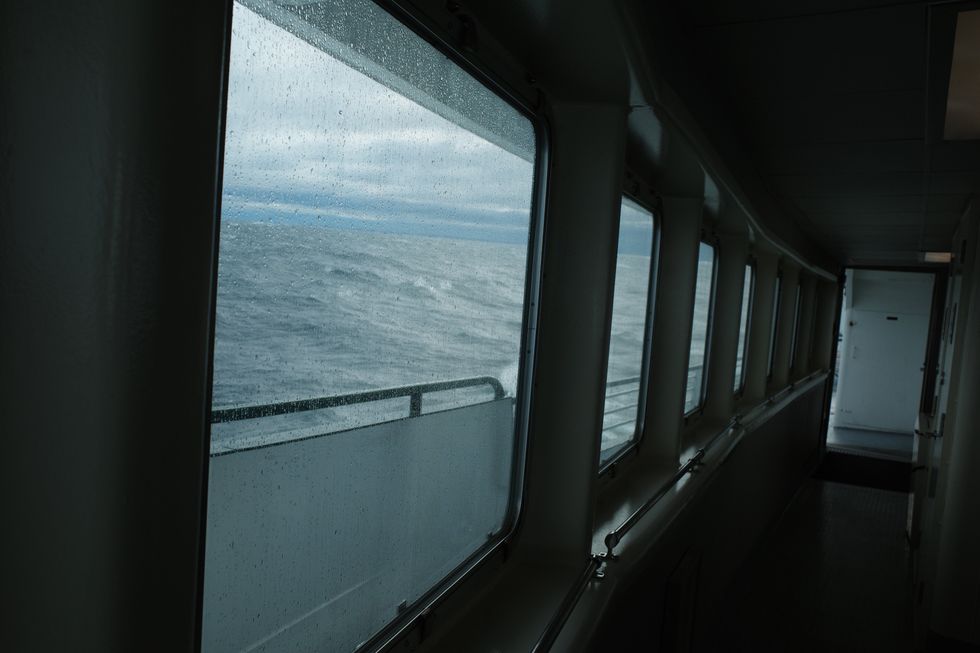
Checking out at McDonough’s, the clerk noticed the tube of Dramamine on the belt. “I heard it was a rough ride the other day.” She knew what November on Lake Michigan meant. She told me her son had a dentist appointment on the mainland the other day, but she canceled because of the weather. An hour and a half of seasickness is the price you pay if you need to get off the island. But even the hardiest people used to life out here in the middle of nowhere will postpone the appointment for another day.
An old cemetery looms across the street from St. James Episcopal Church. Surrounded by a thin chain link fence, brown, crunchy leaves gather in the corners and next to gravestones—new graves, old graves, unmarked graves. Long ago, sailors would find bodies floating in the lake and stop here on Beaver Island to lay them to rest.
St. James Township Hall is right on the water. With white siding and a red roof, it’s the size of an unremarkable two-bedroom house. Paradise Bay is just beyond the back door. Charlevoix State Bank is the only bank on the island. A wooden homemade “BANK” sign hangs above a small green door. A standard-issue orange and black “CLOSED” sign—the kind you see in a mom-and-pop hardware store—hangs in the window. Next door, in the same building, is the Whiskey Point Brewing Company.
Construction workers hammer away all afternoon downtown. Sawhorses and plywood are lying just off the shore. Along sun-drenched backroads, old cars and older boats sit next to outbuildings and detached garages. As we walk along King’s Highway—a residential street with a speed limit of 25 mph—the bartender from the Shamrock, on her way home, slows to roll down her window. “Hi!” she calls with a wave. We hear the sound of a different engine in the distance. Looking south, a small plane rises up from the trees and heads out over the water on its way to the mainland.
The scenes on Beaver Island are stunning—not because they are fantastical displays of material perfection, but because they are real. The streets aren’t lined with hundreds of extravagant homes or BMWs. All the typical signs of a resort area are absent. The houses on the island are normal, real—adorned with dirty trucks, old bikes, rugged land, piles of chopped cords for wood-burning stoves running all winter.
In our decadent age, we are spoiled. We are used to getting whatever we want whenever we want it. We can order a car—maybe driverless—and hit the road. We can order a meal for delivery within the hour. The weather doesn’t deter us. Even in a storm, we can go somewhere else. In climate-controlled luxury, we are never truly isolated. We have seemingly insulated ourselves from the concerns of the weather and the world. We exist in the heart of pampered luxury civilization.
But not on Beaver Island: there are the boats that won’t run because of the waves, the planes that can’t fly because of the winds. Plans are made and plans are changed. Every appointment off-island is subject to cancellation. Additional planning is needed every step of the way. A dose of flexibility is expected after that.
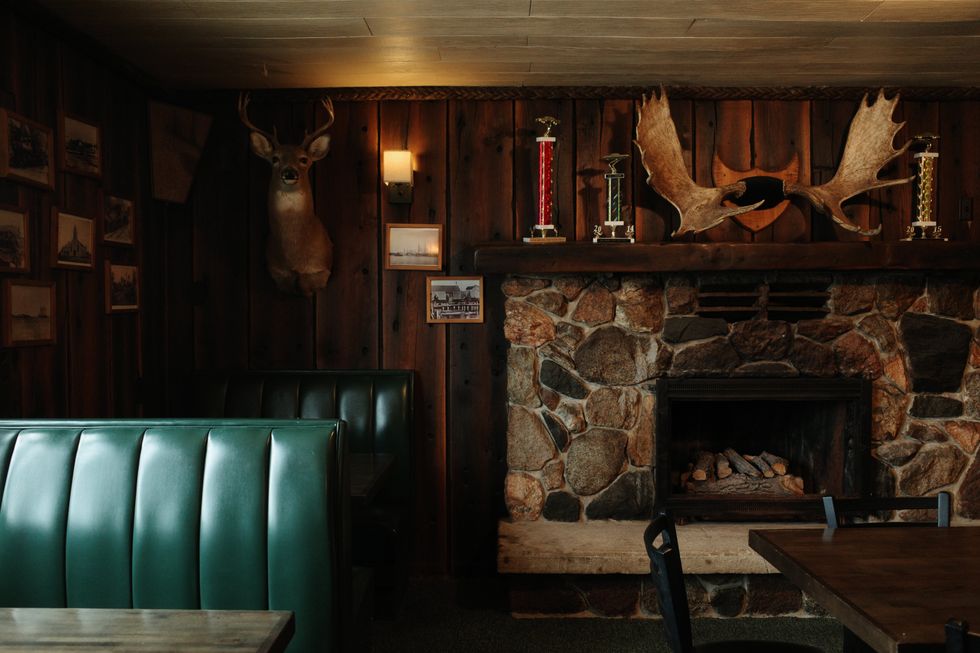
Beaver Island doesn’t have DoorDash. There’s no drive-thru, no 24-hour grocery stores, no way to hack the price and get a better deal somewhere else. You can’t get anything easily. Every single thing takes longer to get here—clothes, computers, cars, lumber, supplies, food, medicine, people. In its isolation, life on Beaver Island is a stark acknowledgment of reality, nature, geography, and circumstance—a brutal lesson that pushes us up against the wall with no way to squirm out.
Only beyond the edge of luxury civilization is an encounter with deeper, more honest layers of life possible.
A distinct sense takes hold somewhere in our gut when we are alone or isolated far from settled luxury. On this island in the northern stretch of Lake Michigan, an inescapable loneliness or disconnectedness falls over us. But it’s not discomforting. It’s like an opening of the self—a feeling of liberation and knowledge of place. The stars are brighter, the nights quieter, the horizon darker.
This great isolation that comes from being on the frontier bears with it a sense of freedom and a kind of radical independence of self and knowledge that cannot be tapped in any other way. On this little island, there still remains some glimpse of freedom left to grab and seize for those who are willing.
A kind of dance plays under the surface here. What draws us—or the bold among us—toward that dance?
First the American Indians lived here. Then traders and sailors stayed on the island—some Irish too. Then a cult leader named James Strang and his polygamist followers sought out refuge beyond the edge of civilization. And today, we are here. The world has changed, but the island has not—or at least, its juxtaposition and relation to the mainland and luxurious civilization is the same as it was before. It is a place beyond the edge, where that dance below the surface lives.
Walking along the bay at twilight, we watched workers finishing their day near a dock, loading drills and hammers into the backs of dented trucks. The movements of cigarette smoke and blue jeans filled the scene as a gaggle of turkeys waddled alongside a closed garage and a family of ducks floated on the motionless water. The orange and glasslike sky broke sunlight through the reeds onshore. The cold still of autumn permeated the air—so very different from the bitter wind on the boat the day before. Every few minutes, a car idled by—its passengers waving through their window, turning around where the road ends and the water begins, and then heading back in the other direction again.
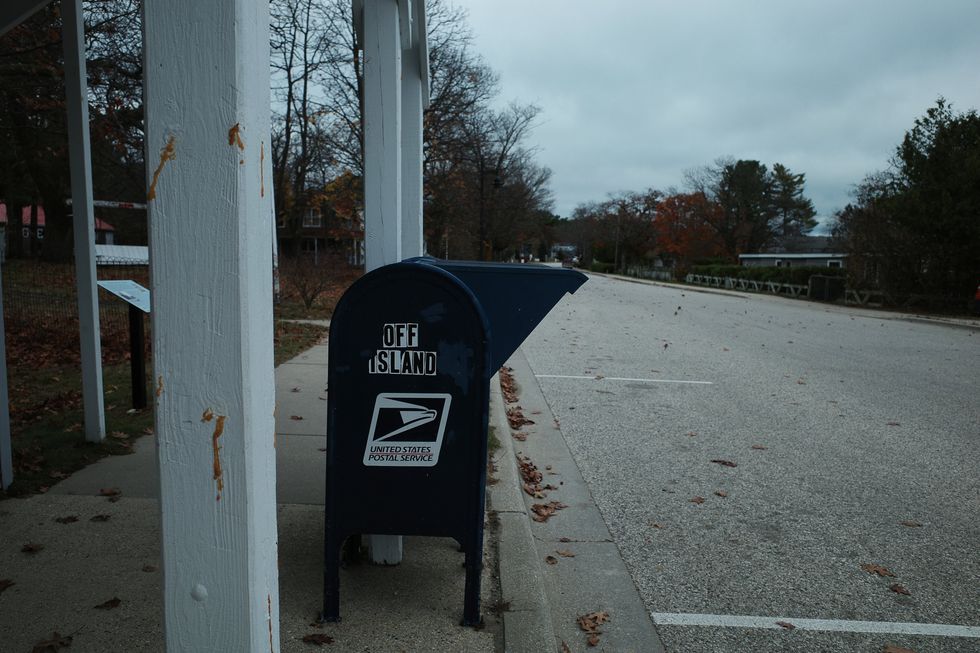
The Beaver Island Harbor Light stands on the eastern tip of Paradise Bay. It’s the first thing you see when you arrive and the last thing you pass on your way out. The old lighthouse watches over a rocky tide. The sky grows dimmer as the night wears on—the light above the trees fades from yellow to orange, then red to purple. A barge slowly creeps out of the bay heading east and back to the mainland under a near full moon in the northern sky.
My son took a glass bottle from his jacket with a message he had dictated to me tucked inside. He inched into the water as far as his rubber duck boots would take him and threw the bottle as far as he could muster out into the rippling waves. We stood there, together watching the colored sky and the gentle water for a while in silence. Alone on the shore. The white tail of a jet sailing across the evening sky high overhead.
Those moments on the shore were the greatest I experienced that year. I keep returning to that dance on the edge of a knife.
It’s not easy to get to Beaver Island. It’s not easy to be on Beaver Island. Only the toughest deserve the glory of life here. It’s no coincidence that standing beyond the edge of luxurious civilization, I experienced a brief span of time that will burn in my consciousness for perhaps as long as I live. I understood why they live here and what it means. But I had to get there. I had to go beyond the edge.
Honest realism; harsh sublimity—that’s the meaning of life on Beaver Island.
O.W. Root is a northern Michigan-based writer with a focus on style, aesthetics, culture, and modern life. Additionally, he is a writer for Michigan Enjoyer.
O.W. Root